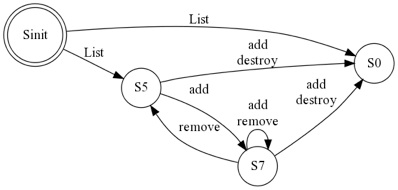Contractor Validation Tool




Lets say we have the following C code (named “List.c”) implementing a singly-linked list.
#include <stdio.h>
#include <stdlib.h>
typedef int boolean;
typedef struct node {
int data;
struct node *next;
} node;
typedef struct list {
int size;
node* first;
} list;
list* l;
boolean List() {
l = (list*) malloc(sizeof(list));
if (l == 0) {
printf("Error! memory is not available\n");
return 0;
}
l->size = 0;
l->first = 0;
return 1;
}
boolean add(int data){
node *tmp = l->first;
while (tmp->next != l->first)
tmp = tmp->next;
tmp->next = (node*) malloc(sizeof(node));
if(tmp->next == 0) {
printf("Error! memory is not available\n");
l = 0;
return 0;
}
tmp = tmp->next;
tmp->data = data;
tmp->next = l->first;
l->size++;
return 1;
}
void remove(){
l->size--;
node* new_first = l->first->next;
free(l->first);
l->first = new_first;
}
void destroy()
{
node* current;
node* tmp;
current = l->first;
l->first = 0;
while(current != 0) {
tmp = current->next;
free(current);
current = tmp;
}
l = 0;
}
We would like to validate it and see if it has any bugs using Contractor. In order to do so, we will follow 4 steps:
-
1.Write an invariant for the list structure.
-
2.Write preconditions for each of the actions.
-
3.Create a binding file.
-
4.Construct an abstraction using Contractor.
Step 1: writing an invariant
Writing an invariant for the list is an easy task, we just need to specify that either l is NULL, or its size attribute is non-negative.
boolean invariant() {
return l == 0 || l->size >= 0;
}
Step 2: writing preconditions
Writing preconditions is trickier. We need to split the condition for each action into two parts:
-
 A system precondition part that predicates over the list structure.
A system precondition part that predicates over the list structure. -
 A parameter precondition part that predicates over the action parameters.
A parameter precondition part that predicates over the action parameters.
Considering that, since the List action is going to be considered an “initializer”, it will only have a parameter precondition. Furthermore, as it takes no parameters, it is trivial to write:
boolean par_pre_List() {
return 1;
}
The add operation requires the list structure not to be NULL. It imposes no restriction over the parameter.
boolean sys_pre_add() {
return l != 0;
}
boolean par_pre_add(int data) {
return 1;
}
The remove operation is similar but it also requires the list to be not empty.
boolean sys_pre_remove() {
return l != 0 && l->size > 0;
}
boolean par_pre_remove() {
return 1;
}
Finally, the destroy operation, which has the same restrictions as adding elements.
boolean sys_pre_destroy() {
return l != 0;
}
boolean par_pre_destroy() {
return 1;
}
Step 3: writing a binding file
We now need to write a binding file, which indicates:
-
 Which function is the invariant.
Which function is the invariant. -
 Which functions are initializers, together with their preconditions.
Which functions are initializers, together with their preconditions. -
 Which other functions are there, together with their preconditions.
Which other functions are there, together with their preconditions.
So we proceed and create a file named List.binding (which can be found in the examples page):
<code-binding name="List" language="c"
file="List.c" inv="return invariant();" >
<initializer name="List" pre="return sys_pre_List();"
params_pre="return par_pre_List();" />
<function name="add" pre="return sys_pre_add();"
params_pre="return par_pre_add(data);" >
<parameter type="int" name="data" />
</function>
<function name="remove" pre="return sys_pre_remove();"
params_pre="return par_pre_remove();" />
<function name="destroy" pre="return sys_pre_destroy();"
params_pre="return par_pre_destroy();" />
</code-binding>
Step 4: running Contractor
We must indicate contractor that we are using code with preconditions as input. We will also set a flag in order to get its output in PNG format.
contractor -i code-with-pre -o png List.binding -f List.png
Which will produce the following PNG image (named List.png):

Tutorial 2: Contractor for code validation

